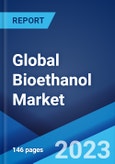The global bioethanol market size reached US$ 9.4 Billion in 2022. Looking forward, the market is expected to reach US$ 14.3 Billion by 2028, exhibiting a growth rate (CAGR) of 7.24% during 2022-2028.
Bioethanol is a clear, colorless liquid produced from biomass by hydrolysis and sugar fermentation or using the chemical process of reacting ethylene with steam. It is biodegradable, less toxic, and does not cause environmental pollution as compared to conventional fuels. Consequently, it is gaining traction as a petrol substitute for road transport vehicles around the world. It is blended with petrol without modifying engine designs, which results in reduced greenhouse gas (GHG) emissions and air pollution. Presently, the ongoing research and development activities to produce bioethanol fuel using municipal solid waste are escalating the demand for bioethanol worldwide.
Bioethanol is a clear, colorless liquid produced from biomass by hydrolysis and sugar fermentation or using the chemical process of reacting ethylene with steam. It is biodegradable, less toxic, and does not cause environmental pollution as compared to conventional fuels. Consequently, it is gaining traction as a petrol substitute for road transport vehicles around the world. It is blended with petrol without modifying engine designs, which results in reduced greenhouse gas (GHG) emissions and air pollution. Presently, the ongoing research and development activities to produce bioethanol fuel using municipal solid waste are escalating the demand for bioethanol worldwide.
Bioethanol Market Trends
The suburbanization trend and boosting sales of passenger vehicles across the globe on account of inflating disposable incomes represent one of the key factors influencing the market positively. Moreover, the growing environmental concerns among individuals are driving the demand for bioethanol as an alternative to fossil fuels. Apart from this, improving road transport networks are resulting in the increasing use of commercial vehicles. As these vehicles contribute disproportionately to air pollution and congestion, government bodies of numerous countries are implementing stringent regulations to minimize pollutant emissions and encourage the adoption of bioethanol. In addition, bioethanol finds application in existing engines to reduce the amount of carbon monoxide, thereby assisting in improving the overall air quality. Furthermore, as it is skin-friendly and harmless for the health and environment, bioethanol is widely used as a carrier and solvent in cosmetics and personal care products across the globe. It is also employed in the pharmaceutical industry as a major ingredient for formulating drugs, cough syrups, medicinal capsules, and disinfectants. Moreover, it is gaining traction in the food and beverage (F&B) industry as a flavor enhancer.Key Market Segmentation
This research provides an analysis of the key trends in each sub-segment of the global bioethanol market report, along with forecasts at the global, regional and country level from 2023-2028. The report has categorized the market based on type, fuel blend, generation and end use industry.Breakup by Type:
- Sugarcane-based Ethanol
- Cellulosic Ethanol
- Starch-based Ethanol
Breakup by Fuel Blend:
- E10
- E20 and E25
- E70 and E75
- E85
Breakup by Generation:
- First Generation
- Second Generation
- Third Generation
Breakup by End Use Industry:
- Automotive and Transportation
- Power Generation
- Pharmaceutical
- Food and Beverage
- Cosmetics and Personal Care
Breakup by Region:
- North America
- United States
- Canada
- Asia-Pacific
- China
- Japan
- India
- South Korea
- Australia
- Indonesia
- Europe
- Germany
- France
- United Kingdom
- Italy
- Spain
- Russia
- Latin America
- Brazil
- Mexico
- Middle East and Africa
Competitive Landscape
The competitive landscape of the industry has also been examined along with the profiles of the key players being Abengoa S.A., Archer-Daniels-Midland Company, BP plc, Cristalco (Cristal Union), CropEnergies AG (Südzucker AG), Flint Hills Resources, LLC (Koch Industries, Inc.), Green Plains Inc., Honeywell International Inc., INEOS Capital Limited, Petróleo Brasileiro S.A., POET LLC, Royal Dutch Shell plc and Valero Energy Corporation.Key Questions Answered in This Report:
- How has the global bioethanol market performed so far and how will it perform in the coming years?
- What has been the impact of COVID-19 on the global bioethanol market?
- What are the key regional markets?
- What is the breakup of the market based on the type?
- What is the breakup of the market based on the fuel blend?
- What is the breakup of the market based on the generation?
- What is the breakup of the market based on the end use industry?
- What are the various stages in the value chain of the industry?
- What are the key driving factors and challenges in the industry?
- What is the structure of the global bioethanol market and who are the key players?
- What is the degree of competition in the industry?
Table of Contents
1 Preface3 Executive Summary12 Value Chain Analysis14 Price Analysis
2 Scope and Methodology
4 Introduction
5 Global Bioethanol Market
6 Market Breakup by Type
7 Market Breakup by Fuel Blend
8 Market Breakup by Generation
9 Market Breakup by End Use Industry
10 Market Breakup by Region
11 SWOT Analysis
13 Porters Five Forces Analysis
15 Competitive Landscape
Companies Mentioned
- Abengoa S.A.
- Archer-Daniels-Midland Company
- BP plc
- Cristalco (Cristal Union)
- CropEnergies AG (Südzucker AG)
- Flint Hills Resources
- LLC (Koch Industries Inc.)
- Green Plains Inc.
- Honeywell International Inc.
- INEOS Capital Limited
- Petróleo Brasileiro S.A.
- POET LLC
- Royal Dutch Shell plc
- Valero Energy Corporation
Methodology

LOADING...
Table Information
| Report Attribute | Details |
|---|---|
| No. of Pages | 146 |
| Published | November 2023 |
| Forecast Period | 2022 - 2028 |
| Estimated Market Value ( USD | $ 9.4 Billion |
| Forecasted Market Value ( USD | $ 14.3 Billion |
| Compound Annual Growth Rate | 7.2% |
| Regions Covered | Global |
| No. of Companies Mentioned | 14 |









